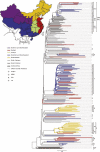The rapidly expanding CRF01_AE epidemic in China is driven by multiple lineages of HIV-1 viruses introduced in the 1990s
- PMID: 23807275
- PMCID: PMC3819312
- DOI: 10.1097/QAD.0b013e328360db2d
The rapidly expanding CRF01_AE epidemic in China is driven by multiple lineages of HIV-1 viruses introduced in the 1990s
Abstract
Objectives: We sought to comprehensively analyze the origin, transmission patterns and sub-epidemic clusters of the HIV-1 CRF01_AE strains in China.
Methods: Available HIV-1 CRF01_AE samples indentified in national molecular epidemiologic surveys were used to generate near full-length genome (NFLG) sequences. The new and globally available CRF01_AE NFLG sequences were subjected to phylogenetic and Bayesian molecular clock analyses, and combined with epidemiologic data to elucidate the history of CRF01_AE transmission in China.
Results: We generated 75 new CRF01_AE NFLG sequences from various risk populations covering all major CRF01_AE epidemic regions in China. Seven distinct phylogenetic clusters of CRF01_AE were identified. Clusters 1, 2 and 3 were prevalent among heterosexuals and IDUs in southern and southwestern provinces. Clusters 4 and 5 were found primarily among MSM in major northern cities. Clusters 6 and 7 were only detected among heterosexuals in two southeast and southwest provinces. Molecular clock analysis indicated that all CRF01_AE clusters were introduced from Southeast Asia in the 1990s, coinciding with the peak of Thailand's HIV epidemic and the initiation of China's free overseas travel policy for their citizens, which started with Thailand as the first destination country.
Conclusion: China's HIV-1 epidemic of sexual transmissions, was initiated by multilineages of CRF01_AE strains, in contrast to the mono-lineage epidemic of B' strain in former plasma donors and IDUs. Our study underscores the difficulty in controlling HIV-1 sexual transmission compared with parenteral transmission.
Figures
Similar articles
-
The Epidemic Dynamics of Four Major Lineages of HIV-1 CRF01_AE Strains After Their Introduction into China.AIDS Res Hum Retroviruses. 2016 May;32(5):420-6. doi: 10.1089/AID.2015.0212. Epub 2016 Mar 16. AIDS Res Hum Retroviruses. 2016. PMID: 26830205
-
Molecular epidemiological study of HIV-1 CRF01_AE transmission in Hong Kong.J Acquir Immune Defic Syndr. 2009 Aug 15;51(5):530-5. doi: 10.1097/QAI.0b013e3181aac516. J Acquir Immune Defic Syndr. 2009. PMID: 19521252
-
Reconstituting the epidemic history of mono lineage of HIV-1 CRF01_AE in Guizhou province, Southern China.Infect Genet Evol. 2014 Aug;26:139-45. doi: 10.1016/j.meegid.2014.05.006. Epub 2014 May 10. Infect Genet Evol. 2014. PMID: 24823961
-
The Emerging of CRF01_AE: A Clinical Story and Future HIV/AIDS Situation in Thailand.Curr HIV Res. 2020;18(2):74-84. doi: 10.2174/1570162X18666200129160723. Curr HIV Res. 2020. PMID: 31995011 Review.
-
HIV Epidemic in Asia: Implications for HIV Vaccine and Other Prevention Trials.AIDS Res Hum Retroviruses. 2015 Nov;31(11):1060-76. doi: 10.1089/aid.2015.0049. Epub 2015 Jun 24. AIDS Res Hum Retroviruses. 2015. PMID: 26107771 Free PMC article. Review.
Cited by
-
Identification of a novel HIV-1 intra-circulating recombinant form 01_AE in China: a descendant of the previously identified CRF01_AE transmission clusters 1 and 6.Sci China Life Sci. 2015 Jul;58(7):724-6. doi: 10.1007/s11427-015-4888-2. Epub 2015 Jun 22. Sci China Life Sci. 2015. PMID: 26100011 Free PMC article.
-
Distinct genetic clusters in HIV-1 CRF01_AE-infected patients induced variable degrees of CD4+ T-cell loss.mBio. 2024 Mar 13;15(3):e0334923. doi: 10.1128/mbio.03349-23. Epub 2024 Feb 22. mBio. 2024. PMID: 38385695 Free PMC article.
-
Identification of two near-identical novel HIV-1 unique recombinant forms (CRF01_AE/B) among men who have sex with men in baoding, hebei, China.Front Genet. 2023 Feb 2;14:1105739. doi: 10.3389/fgene.2023.1105739. eCollection 2023. Front Genet. 2023. PMID: 36873951 Free PMC article.
-
New Genomes from the Congo Basin Expand History of CRF01_AE Origin and Dissemination.AIDS Res Hum Retroviruses. 2020 Jul;36(7):574-582. doi: 10.1089/AID.2020.0031. Epub 2020 May 18. AIDS Res Hum Retroviruses. 2020. PMID: 32281388 Free PMC article.
-
Characterization of the HIV-1 molecular network in a middle-aged population aged 50 years and older in a City in Southern Sichuan, China.Sci Rep. 2025 Mar 26;15(1):10500. doi: 10.1038/s41598-025-95660-0. Sci Rep. 2025. PMID: 40140708 Free PMC article.
References
-
- McCutchan FE, Hegerich PA, Brennan TP, Phanuphak P, Singharaj P, Jugsudee A, et al. Genetic variants of HIV-1 in Thailand. AIDS Res Hum Retroviruses 1992; 8:1887–1895 - PubMed
-
- Nelson KE, Celentano DD, Suprasert S, Wright N, Eiumtrakul S, Tulvatana S, et al. Risk factors for HIV infection among young adult men in northern Thailand. JAMA 1993; 270:955–960 - PubMed
-
- Robertson DL, Sharp PM, McCutchan FE, Hahn BH. Recombination in HIV-1. Nature 1995; 374:124–126 - PubMed
Publication types
MeSH terms
Associated data
- Actions
- Actions
- Actions
- Actions
- Actions
- Actions
- Actions
- Actions
- Actions
- Actions
- Actions
- Actions
- Actions
- Actions
- Actions
- Actions
- Actions
- Actions
- Actions
- Actions
- Actions
- Actions
- Actions
- Actions
- Actions
- Actions
- Actions
- Actions
- Actions
- Actions
- Actions
- Actions
- Actions
- Actions
- Actions
- Actions
- Actions
- Actions
- Actions
- Actions
- Actions
- Actions
- Actions
- Actions
- Actions
- Actions
- Actions
- Actions
- Actions
- Actions
- Actions
- Actions
- Actions
- Actions
- Actions
- Actions
- Actions
- Actions
- Actions
- Actions
- Actions
- Actions
- Actions
- Actions
- Actions
- Actions
- Actions
- Actions
- Actions
- Actions
- Actions
- Actions
- Actions
- Actions
- Actions
Grants and funding
LinkOut - more resources
Full Text Sources
Other Literature Sources
Medical
Molecular Biology Databases




